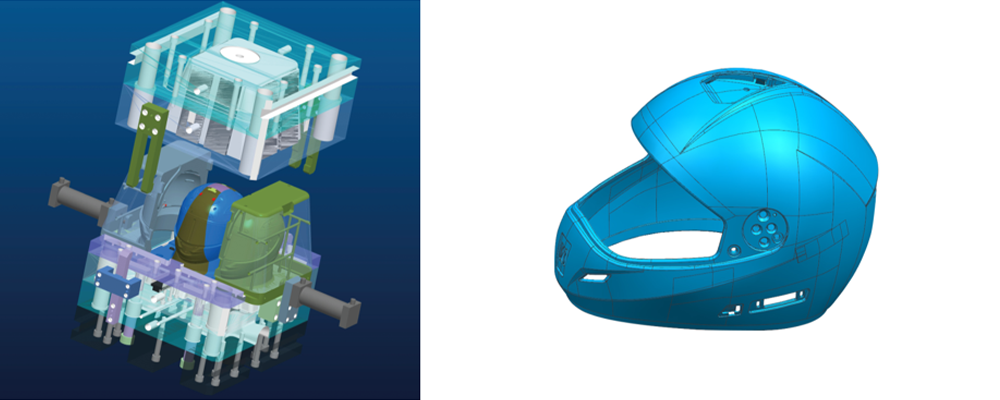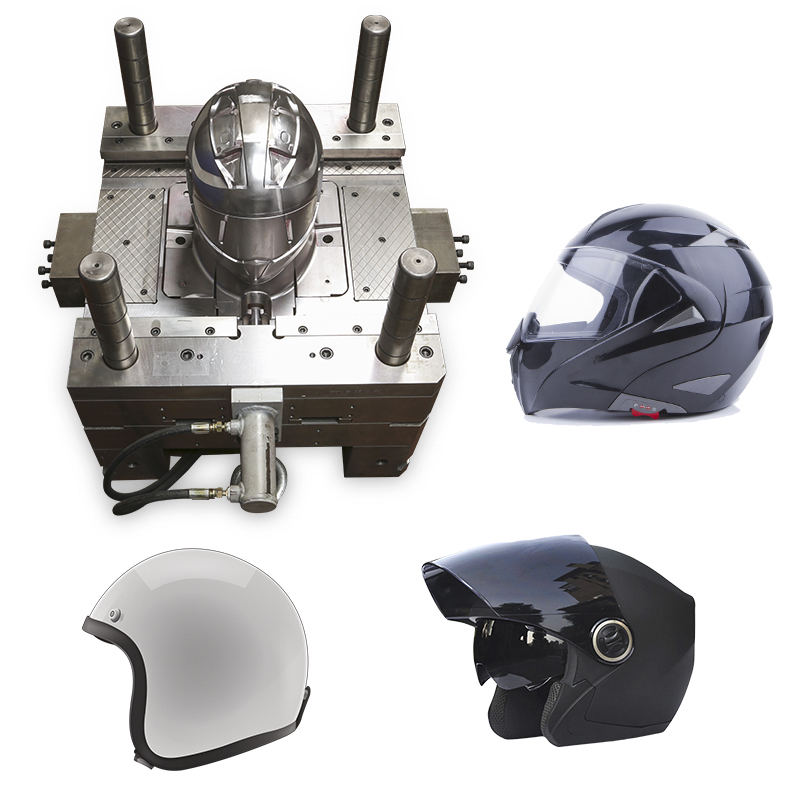Motorcycle plastic injection molds are essential tools in the production of plastic components for motorcycles. From fairings to lighting covers, these molds define the structure, appearance, and functionality of critical parts.
Types of Motorcycle Plastic Injection Molds
Motorcycles require a variety of plastic parts, each with unique design and performance requirements. Here are the most common types of injection molds:
1. Fairing Molds
Purpose: Fairings protect internal components and reduce air resistance.
Design Features: These molds need precise contours to create smooth, aerodynamic surfaces and allow for perfect assembly with other body parts.
Materials Used: Typically, ABS plastic is used for its impact resistance and glossy finish.
2. Headlight and Taillight Cover Molds
Purpose: These molds produce transparent plastic covers that protect lighting systems.
Critical Challenges: Ensuring optical clarity is paramount, requiring polished mold cavities and high-quality materials like polycarbonate (PC).
3. Fuel Tank Cover Molds
Purpose: Protecting the fuel tank and providing an ergonomic interface for the rider.
Design Requirements: These molds focus on impact resistance and durability, as well as aesthetic appeal.
4. Handlebar and Control Panel Cover Molds
Purpose: These molds create covers for the handlebar and housing for electronic controls.
Key Features: Ergonomic designs, weatherproof sealing, and compatibility with wiring systems.
5. Decorative Molds (Logos and Trim)
Purpose: Producing logos, emblems, and decorative strips.
Unique Requirements: High precision and intricate detailing to ensure branding elements stand out.
Manufacturing Process of Motorcycle Plastic Injection Molds
The production of high-quality molds involves several technical steps, each tailored to meet the specific demands of motorcycle components:
1. Mold Design
CAD Modeling: Engineers create 3D models using CAD software, incorporating every dimension and tolerance.
Simulation: Advanced simulation tools predict material flow and potential defects, allowing for design optimization.
2. Material Selection
Steel or Aluminum: Most molds are made of hardened steel for longevity or aluminum for rapid prototyping. Steel molds are preferred for high-volume production due to their durability.
3. CNC Machining
Mold Fabrication: CNC machines carve the mold cavity and core with micron-level precision.
Electro-Discharge Machining (EDM): Used for creating intricate details, such as fine surface textures or undercuts.
4. Polishing and Texturing
Mirror Polishing: Essential for molds producing transparent parts like headlight covers.
Texturing: Adds patterns or finishes to enhance grip or aesthetics, such as on handlebar covers.
5. Injection Molding Process
Plastic Melting: High-quality thermoplastics like ABS, PC, or nylon are melted and injected into the mold cavity.
Cooling System: Embedded cooling channels ensure uniform cooling to prevent warping or shrinkage.
Ejection Mechanism: Hydraulic or mechanical ejectors remove the part without causing damage.
Key Roles of Motorcycle Plastic Injection Molds
Motorcycle plastic injection molds are integral to the success of the manufacturing process.
1. Precision and Dimensional Accuracy
Molds ensure every component fits perfectly, whether it’s a fairing, fuel tank cover, or lighting system. A poorly made mold can result in assembly issues, compromising safety and functionality.
2. Enhanced Production Efficiency
Injection molds enable mass production at high speeds, significantly reducing production time. For example, a headlight cover mold can produce hundreds of parts per hour with consistent quality.
3. Customization and Innovation
Modern molds can incorporate complex designs, such as integrated mounting points, decorative patterns, or hidden seams. This allows manufacturers to innovate and create lightweight, multi-functional components.
4. Durability and Safety
High-quality plastic components made using injection molds are resistant to environmental factors such as UV rays, heat, and moisture, ensuring that motorcycles remain reliable even under harsh conditions.
5. Cost-Effectiveness
While mold fabrication involves significant upfront investment, the long-term benefits of durability and high output make injection molding a cost-effective choice for large-scale production.
FAQs: Motorcycle Plastic Injection Molds
What is a motorcycle plastic injection mold?
A motorcycle plastic injection mold is a precision tool used to shape molten plastic into specific motorcycle components such as fairings, lighting covers, fuel tank covers, and handlebar panels through the injection molding process.
What materials are used in motorcycle injection molding?
Common materials include ABS (Acrylonitrile Butadiene Styrene) for fairings, PC (Polycarbonate) for headlight and taillight covers, and nylon for parts requiring high strength and heat resistance.
What are the most commonly molded plastic parts in motorcycles?
Typical molded parts include motorcycle fairings, fuel tank covers, headlight lenses, control panel housings, decorative trims, and logo emblems.
Why is ABS plastic popular for motorcycle fairing molds?
ABS plastic offers excellent impact resistance, heat tolerance, and a glossy surface finish, making it ideal for molding aerodynamic and durable motorcycle fairings.
How are motorcycle plastic injection molds manufactured?
Mold production involves CAD design, CNC machining, EDM (Electro-Discharge Machining), polishing, texturing, and mold testing before mass production begins.
Are plastic injection molds cost-effective for motorcycle manufacturing?
Yes, despite the initial investment, injection molding is cost-effective for large-scale production due to high output rates, consistency, and reduced waste.
How does injection molding improve motorcycle part quality?
Injection molding produces high-precision components with consistent wall thickness, smooth surfaces, and tight tolerances, enhancing both functionality and appearance.
Can motorcycle plastic parts be customized using injection molds?
Absolutely. Injection molds can be designed for custom features such as brand logos, decorative textures, integrated mounts, and unique color options.
What is the lifespan of a motorcycle plastic injection mold?
Steel molds used for motorcycle plastic parts can last for hundreds of thousands of cycles, especially when used with proper maintenance and high-quality materials.
What’s the difference between steel and aluminum molds in motorcycle production?
Steel molds offer greater durability and are suitable for high-volume production, while aluminum molds are used for prototyping and small production runs due to faster machining and lower cost.
How are optical plastic parts like headlight covers molded?
To ensure clarity, headlight and taillight cover molds require mirror-polished surfaces and high-grade materials such as polycarbonate (PC).
What is mold texturing, and why is it important?
Mold texturing adds surface patterns or finishes to plastic parts, improving grip, aesthetics, and product identity, especially on handlebar covers or control panels.
How do cooling systems in molds prevent part defects?
Efficient cooling systems in the injection mold reduce warping, shrinkage, and internal stress, ensuring each motorcycle plastic part retains its designed shape.
Why choose RUNKE for motorcycle plastic injection molds?
RUNKE provides advanced mold design, precise manufacturing, and customized solutions for motorcycle plastic parts. With years of expertise, we ensure every mold meets global quality standards and boosts your production efficiency.
Motorcycle Plastic Injection Molds Manufacturing
Conclusion
Motorcycle plastic injection molds are the backbone of modern motorcycle manufacturing. They enable the production of precise, durable, and visually appealing components such as fairings, lighting covers, fuel tank covers, and more. By understanding the types of molds, their detailed manufacturing process, and their critical role in production, manufacturers can create high-quality parts that meet industry demands for performance, safety, and aesthetics.
As one of the leading motorcycle plastic injection mold manufacturers, RUNKE offers comprehensive solutions tailored to your needs. With advanced design capabilities, state-of-the-art manufacturing technology, and a commitment to quality, we ensure that every mold we produce meets the highest industry standards. Whether you're looking to optimize production efficiency, innovate designs, or enhance the durability of your motorcycle components, RUNKE is your trusted partner in delivering exceptional results.


.jpg)
.jpg)

.jpg)